Optical and Electrical Analyses of Solar Cells with a Radial PN Junction and Incorporating an Innovative NW Design That Mimics ARC Layers
Abstract
1. Introduction
2. Results and Discussions
3. Conclusions
Author Contributions
Funding
Data Availability Statement
Conflicts of Interest
References
- The White House: Office of the Press Secretary. Treasury Releases New Guidance to Drive Clean Energy Investment to America’s Energy Communities. Available online: https://www.whitehouse.gov/cleanenergy/clean-energy-updates/2023/04/04/treasury-releases-new-guidance-to-drive-clean-energy-investment-to-americas-energy-communities/ (accessed on 8 April 2023).
- United Nations Framework Convention on Climate Change. New Mechanism Provides a Key Tool for Countries to Meet Their Climate Goals. Available online: https://unfccc.int/news/new-mechanism-provides-a-key-tool-for-countries-to-meet-their-climate-goals (accessed on 8 April 2023).
- European Commission—Press Release. European Green Deal: EU Agrees Stronger Rules to Boost Energy Efficiency. Available online: https://ec.europa.eu/commission/presscorner/detail/en/ip_23_1581 (accessed on 8 April 2023).
- Department for Energy Security and Net Zero—Policy Paper. Powering up Britain. Available online: https://www.gov.uk/government/publications/powering-up-britain (accessed on 8 April 2023).
- Solangi, K.H.; Islam, M.R.; Saidur, R.; Rahim, N.A.; Fayaz, H. A review on global solar energy policy. Renew. Sustain. Energy Rev. 2011, 15, 2149–2163. [Google Scholar] [CrossRef]
- Khattak, C.P.; Ravi, K.V. Silicon Processing for Photovoltaics; North-Holland Physics Publishing: Chestnut Hill, MA, USA, 1985. [Google Scholar]
- Krebs, F.C. Polymer Photovoltaics: A Practical Approach; SPIE Press: Bellingham, WA, USA, 2008. [Google Scholar]
- International Energy Agency. World Energy Outlook. 2022. Available online: https://www.iea.org/reports/world-energy-outlook-2022 (accessed on 19 April 2023).
- European Comission. Commission Staff Working Document Annual Single Market Report 2021. Available online: https://eur-lex.europa.eu/legal-content/en/TXT/?uri=CELEX%3A52021SC0351 (accessed on 24 March 2023).
- Green, M.A.; Dunlop, E.D.; Siefer, G. Solar cell efficiency tables (Version 61). Prog. Photovolt. Res. Appl. 2023, 31, 3–16. [Google Scholar] [CrossRef]
- LONGi. LONGi once again Sets New World Record for HJT Solar Cell Efficiency. Press Release, 24 June 2022. Available online: https://www.longi.com/en/news/new-hjt-world-record/ (accessed on 19 April 2023).
- Nayak, P.K.; Mahesh, S.; Snaith, H.J.; Cahen, D. Photovoltaic solar cell technologies: Analysing the state of the art. Nat. Rev. Mater. 2019, 4, 269–285. [Google Scholar] [CrossRef]
- Meng, T.; Hamada, H.; Druffel, T.; Lee, J.-J.; Rajeshwar, K. Review—Research Needs for Photovoltaics in the 21st Century. ECS J. Solid State Sci. Technol. 2020, 9, 125010. [Google Scholar]
- Ibrahim, H.; Ilinca, A.; Perron, J. Energy storage systems: Characteristics and comparisons. Renew. Sustain. Energy Rev. 2008, 12, 1221–1250. [Google Scholar] [CrossRef]
- Lotsch, H.K.V.; Goetzberger, A.; Hoffman, V.U. Photovoltaic Solar Energy Generation; Springer: Berlin/Heidelberg, Germany, 2005. [Google Scholar]
- Dan, Y.; Seo, K.; Takei, K.; Meza, J.H.; Javey, A.; Crozier, K.B. Dramatic Reduction of Surface Recombination by in Situ Surface Passivation of Silicon Nanowires. Nano Lett. 2011, 11, 2527–2532. [Google Scholar] [CrossRef] [PubMed]
- Böer, K.W. Handbook of the Physics of Thin-Film Solar Cells; Springer: Berlin/Heidelberg, Germany, 2013. [Google Scholar]
- Seethamraju, S.; Ramamurthy, P.C.; Madras, G. Encapsulation for Improving the Efficiencies of Solar Cells. In Materials and Processes for Solar Fuel Production; Springer: New York, NY, USA, 2014. [Google Scholar]
- Maghami, M.R.; Hizam, H.; Gomes, C.; Radzi, M.A.; Rezadad, M.I.; Hajighorbani, S. Power loss due to soiling on solar panel: A review. Renew. Sustain. Energy Rev. 2016, 59, 1307–1316. [Google Scholar] [CrossRef]
- Ndiaye, A.; Kebe, C.M.F.; Ndiaye, P.A.; Charki, A.; Kobi, A.; Sambou, V. Impact of dust on the photovoltaic modules characteristics after an exposition year in Sahelian environment: The case of Senegal. Int. J. Phys. Sci. 2013, 8, 1166. [Google Scholar] [CrossRef]
- Chander, S.; Purohit, A.; Sharma, A.; Nehra, S.P.; Dhaka, M.S. Impact of temperature on performance of series and parallel connected mono-crystalline silicon solar cells. Energy Rep. 2015, 1, 175–180. [Google Scholar] [CrossRef]
- Luque, A.; Hegedus, S. Handbook of Photovoltaic Science and Engineering, 2nd ed.; John Wiley and Sons, Ltd.: Hoboken, NJ, USA, 2011. [Google Scholar]
- Shockley, W.; Queisser, H.J. Detailed balance limit of efficiency of p–n junction solar cells. J. Appl. Phys. 1961, 32, 510–519. [Google Scholar] [CrossRef]
- Baker-Finch, S.; McIntosh, K. Reflection of normally incident light from silicon solar cells with pyramidal texture. Prog. Photovolt. 2011, 19, 406–416. [Google Scholar] [CrossRef]
- Liu, B.-T.; Hung, T.-Y.; Gorji, N.E.; Mosavi, A.H. Fabrication and characterization of Cesium-doped Tungstate nanorods for Near-Infrared light absorption in dye sensitized solar cells. Results Phys. 2021, 29, 104804. [Google Scholar] [CrossRef]
- Mallorqui, A.; Epple, F.M.; Fan, D.; Demichel, O.; Fontcuberta, A.; Morral, I. Effect of the pn junction engineering on Si microwire-array solar cells. Phys. Status Solidi A 2012, 209, 1588–1591. [Google Scholar] [CrossRef]
- Garnett, E.; Yang, P. Light trapping in silicon nanowire solar cells. Nano Lett. 2010, 10, 1082–1087. [Google Scholar] [CrossRef] [PubMed]
- Gao, Y.; Cansizoglu, H.; Polat, K.G.; Ghandiparsi, S.A.; Mamtaz, H.; Mayet, A.; Wang, Y.; Zhang, X.; Toshishige, Y.; Devine, E.P.; et al. Photon-trapping microstructures enable high-speed high-efficiency silicon photodiodes. Nat. Photonics 2017, 11, 301–308. [Google Scholar] [CrossRef]
- Li, Z.; Wang, J.; Singh, N.; Lee, S. Optical and electrical study of core-shell silicon nanowires for solar applications. Opt. Express 2011, 19, A1057–A1066. [Google Scholar] [CrossRef]
- Saive, R. Light trapping in thin silicon solar cells: A review on fundamentals and technologies. Prog. Photovolt. Res. Appl. 2021, 29, 1125–1137. [Google Scholar] [CrossRef]
- Park, K.; Guo, Z.; Um, H.-D.; Jung, J.-Y.; Yang, J.-M.; Lim, S.K.; Kim, Y.S.; Lee, J.-H. Optical Properties of Si microwires combined with nanoneedles for flexible thin film photovoltaics. Opt. Express 2011, 19, A41. [Google Scholar] [CrossRef]
- Cabrera-España, F.J.; Kamuka, A.; Khaled, A.; Hameed, M.F.O.; Obayya, S.S.A.; Rahman, B.M.A. Optical and Electrical Characteristics of Innovative Solar Cell with Nanowires Mimicking Anti Reflection Coating layers. Prog. Photovolt. 2023, submitted.
- Taflove, A. Advances in FDTD Computational Electrodynamics: Photonics and Nanotechnology; Artech House: London, UK, 2013. [Google Scholar]
- Lumerical Solutions, Inc.; Ansys Canada Ltd.: Vancouver. 2022. Available online: http://www.lumerical.com (accessed on 8 April 2023).
- Kupec, J.; Stoop, R.L.; Witzigmann, B. Light absorption and emission in nanowire array solar cells. Opt. Express 2010, 18, 27589–27605. [Google Scholar] [CrossRef]
- Rahman, B.M.A.; Agrawal, A. Finite Element Modeling Methods for Photonics; Artech House: London, UK, 2013. [Google Scholar]
- Hwang, I.; Jeong, J.; Shiratori, Y.; Park, J.; Miyajima, S.; Yoon, I.; Seo, K. Effective Photon Management of Non-Surface-Textured Flexible Thin Crystalline Silicon Solar Cells. Cell Rep. Phys. Sci. 2020, 1, 100242. [Google Scholar] [CrossRef]
- El-Bashar, R.; Hussein, M.; Hegazy, S.F.; Badr, Y.; Rahman, B.M.A.; Grattan, K.T.V.; Hameed, M.F.O.; Obayya, S.S.A. Electrical performance of efficient quad-crescent-shaped Si nanowire solar cell. Sci. Rep. 2022, 12, 48. [Google Scholar] [CrossRef] [PubMed]
- Gao, Z.; Lin, G.; Chen, Y.; Zheng, Y.; Sang, N.; Li, Y.; Chen, L.; Li, M. Moth-eye nanostructure PDMS films for reducing reflection and retaining flexibility in ultra-thin c-Si solar cells. Sol. Energy 2020, 205, 275–281. [Google Scholar] [CrossRef]

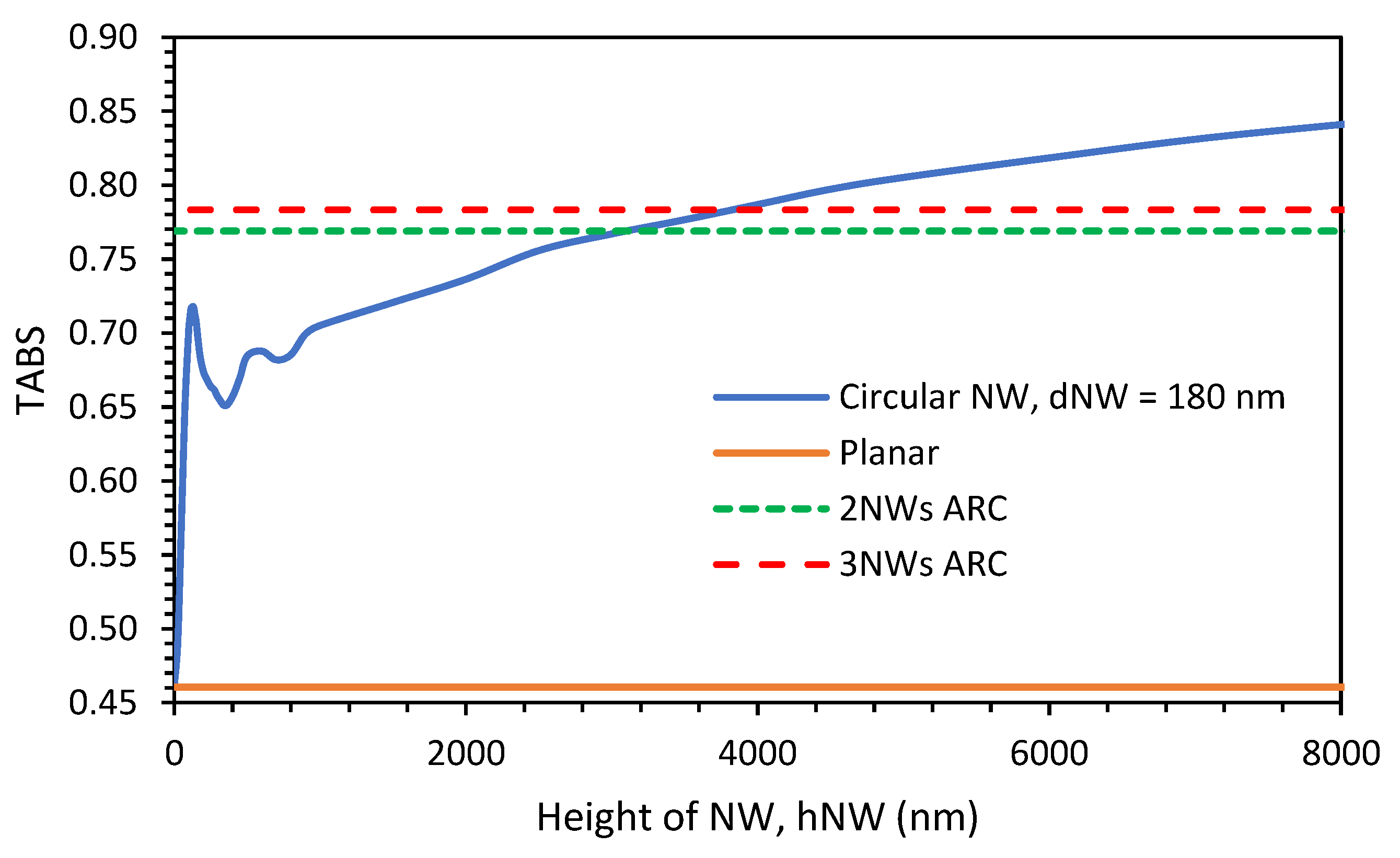
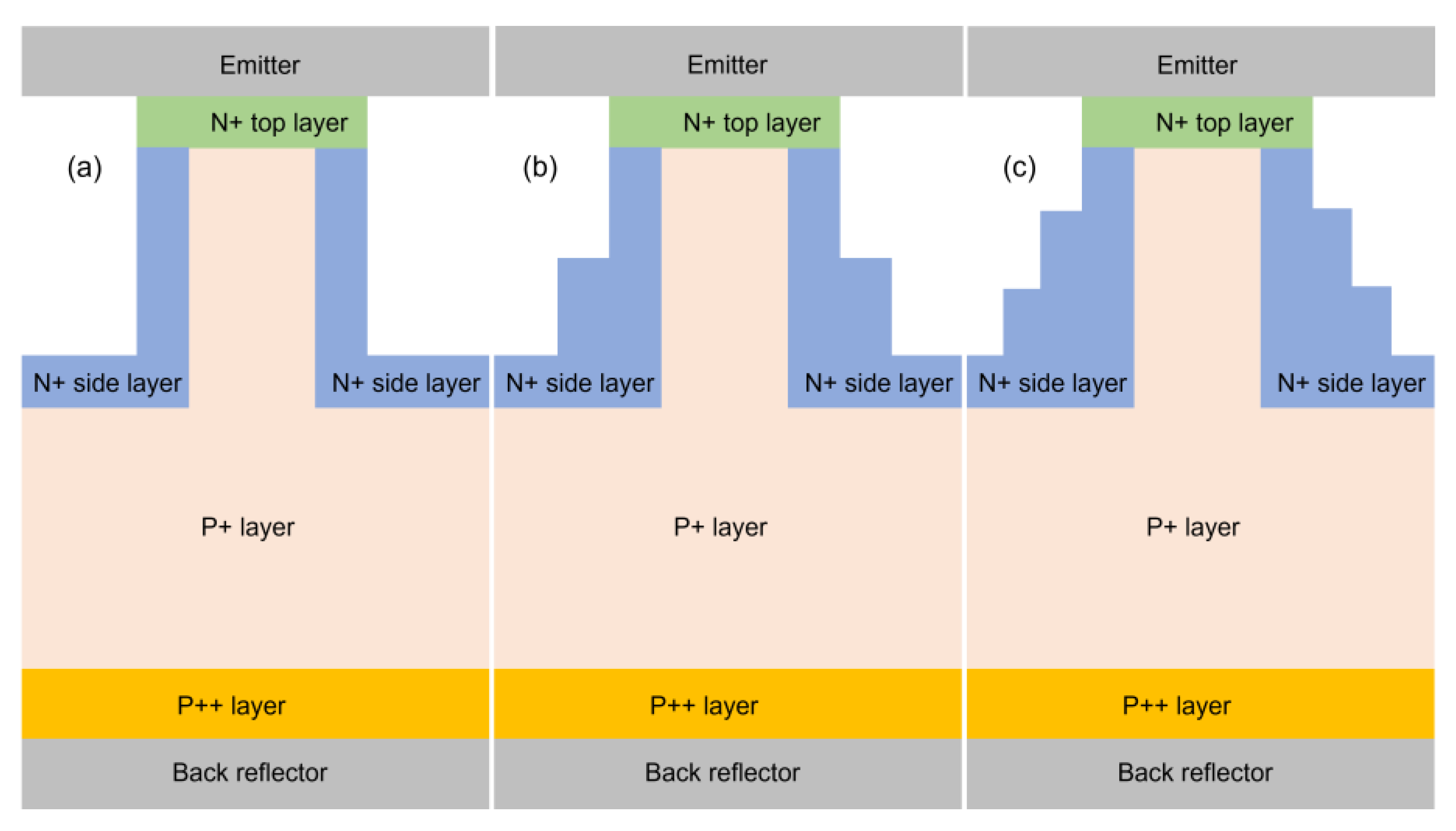
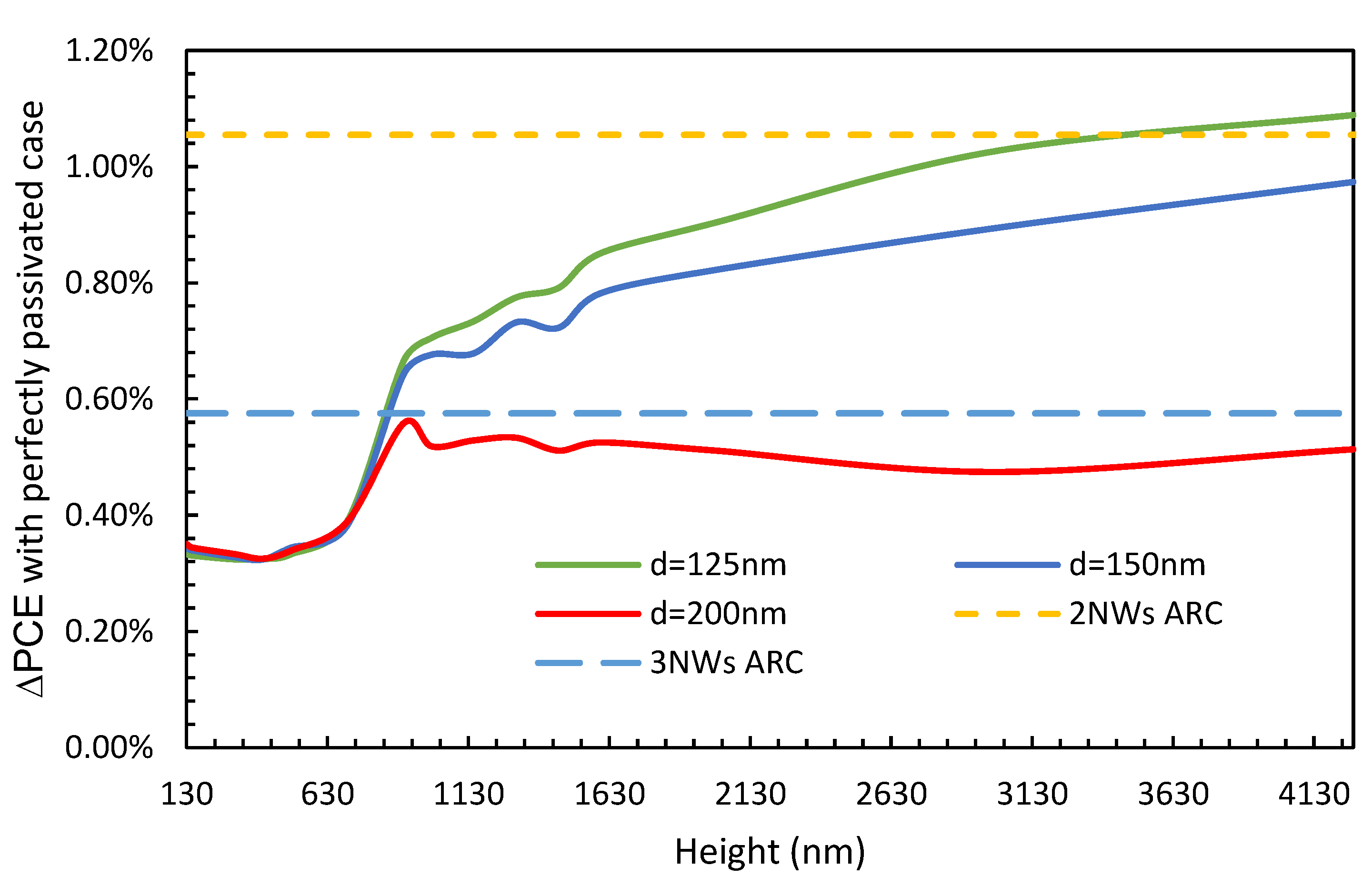
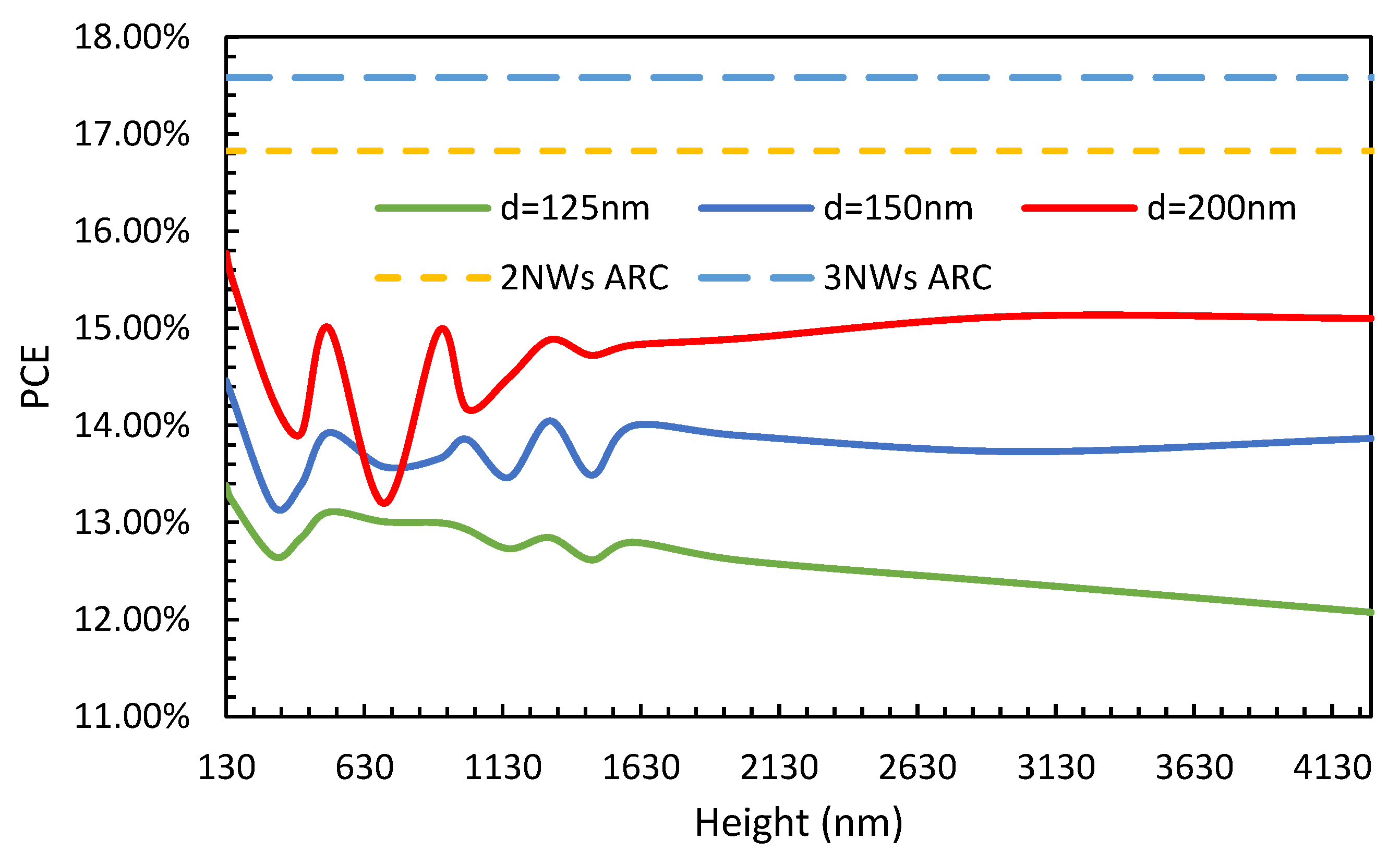
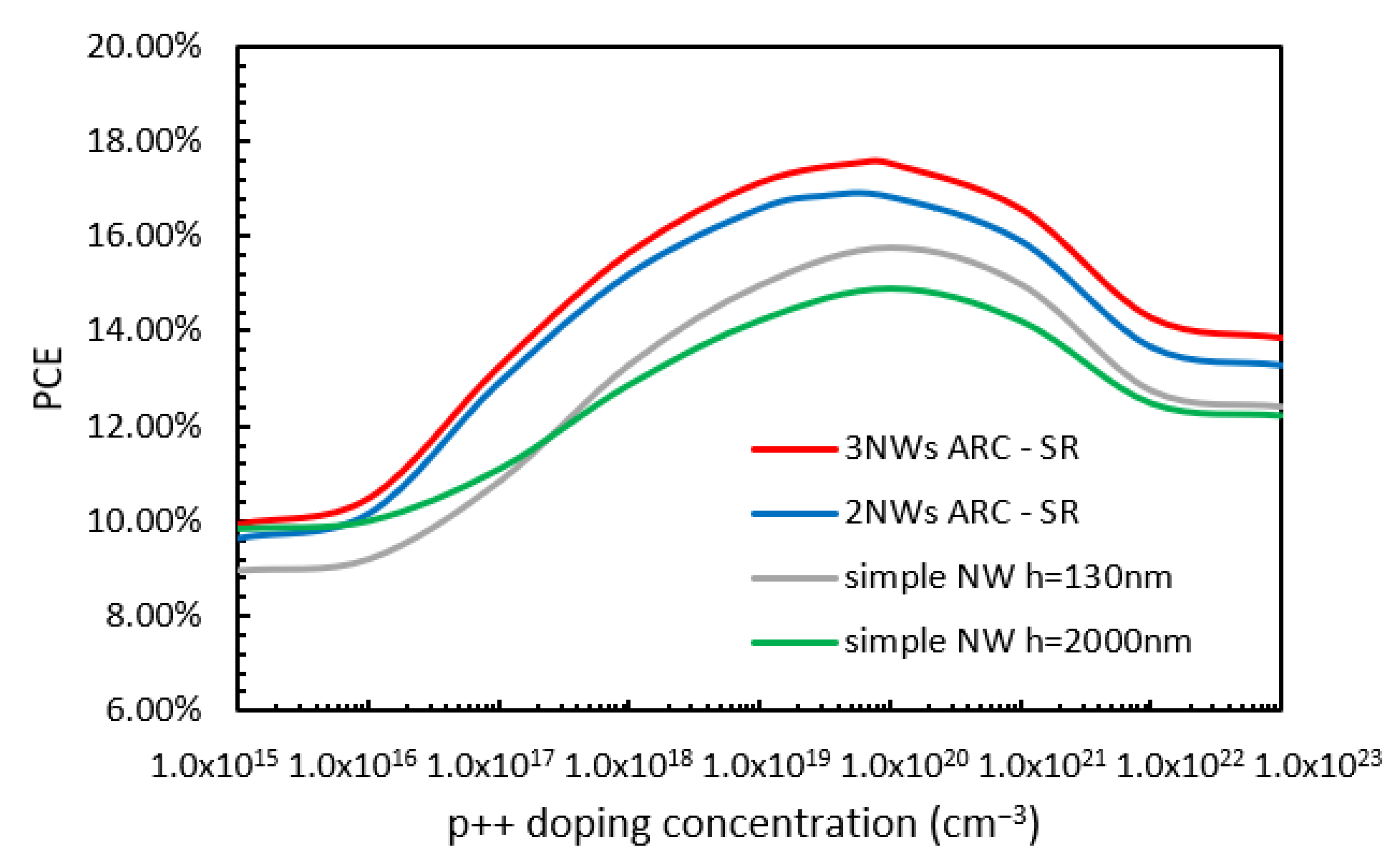
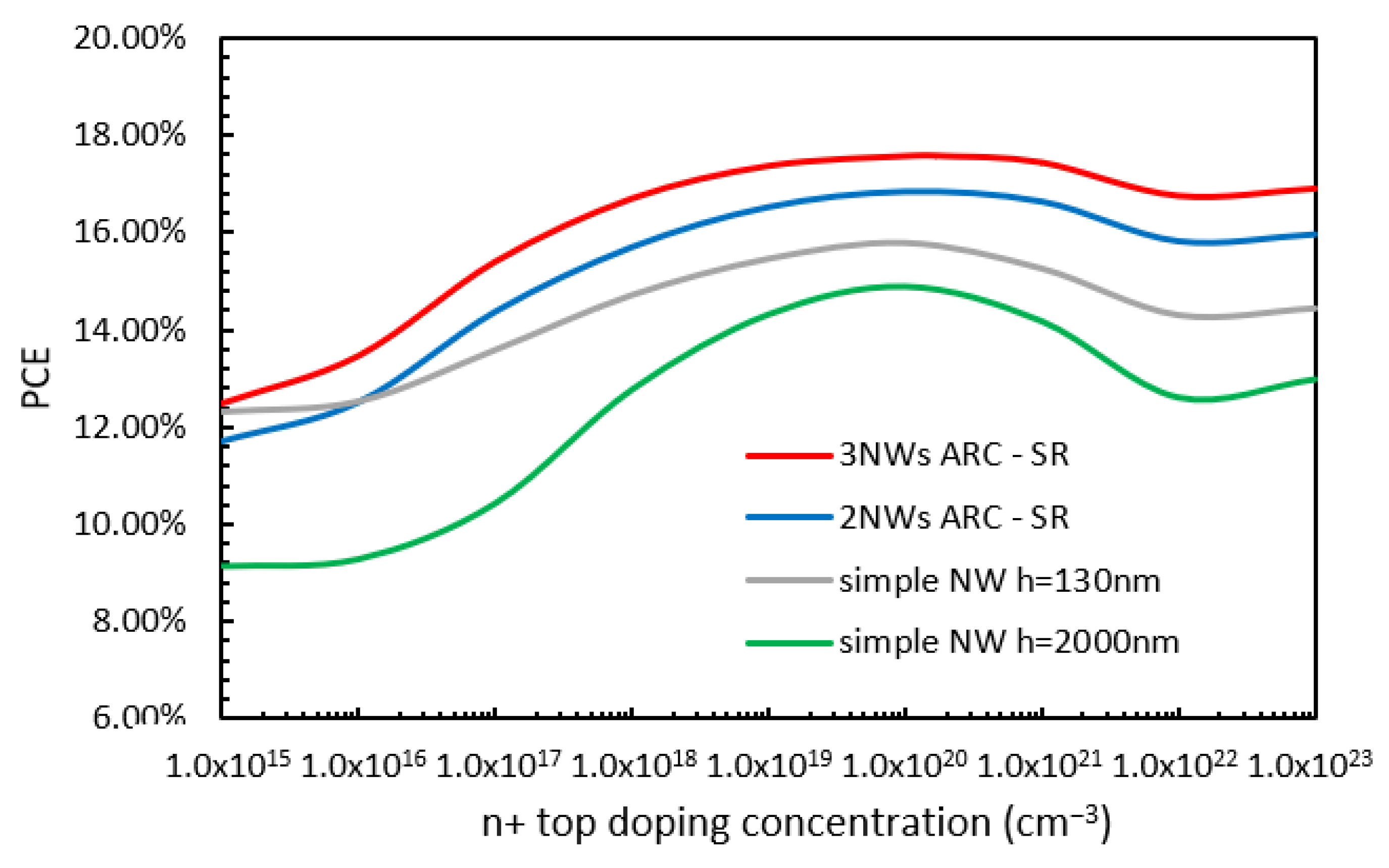

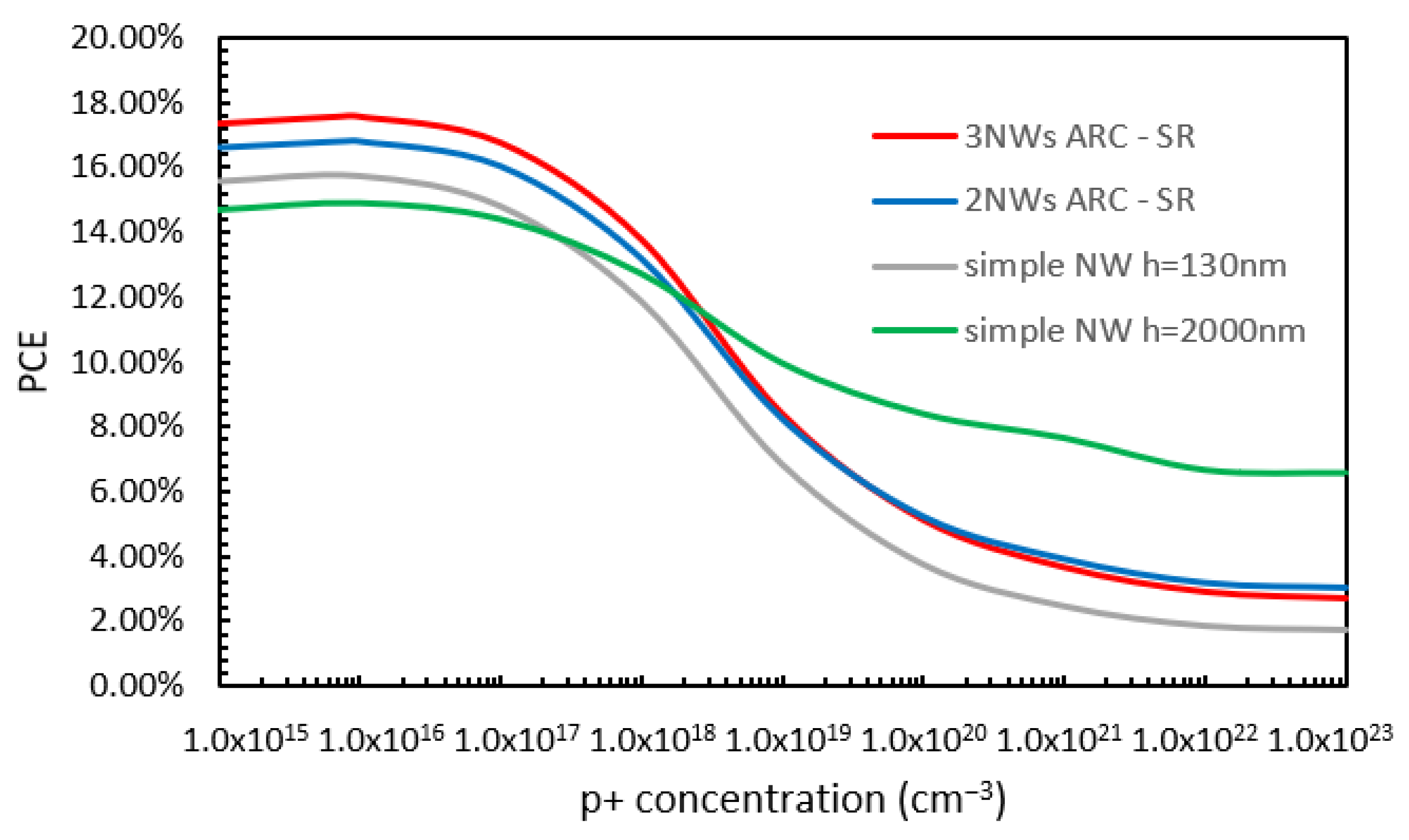
Disclaimer/Publisher’s Note: The statements, opinions and data contained in all publications are solely those of the individual author(s) and contributor(s) and not of MDPI and/or the editor(s). MDPI and/or the editor(s) disclaim responsibility for any injury to people or property resulting from any ideas, methods, instructions or products referred to in the content. |
© 2023 by the authors. Licensee MDPI, Basel, Switzerland. This article is an open access article distributed under the terms and conditions of the Creative Commons Attribution (CC BY) license (https://creativecommons.org/licenses/by/4.0/).
Share and Cite
Cabrera-España, F.J.; Rahman, B.M.A. Optical and Electrical Analyses of Solar Cells with a Radial PN Junction and Incorporating an Innovative NW Design That Mimics ARC Layers. Nanomaterials 2023, 13, 1649. https://doi.org/10.3390/nano13101649
Cabrera-España FJ, Rahman BMA. Optical and Electrical Analyses of Solar Cells with a Radial PN Junction and Incorporating an Innovative NW Design That Mimics ARC Layers. Nanomaterials. 2023; 13(10):1649. https://doi.org/10.3390/nano13101649
Chicago/Turabian StyleCabrera-España, Francisco J., and B. M. Azizur Rahman. 2023. "Optical and Electrical Analyses of Solar Cells with a Radial PN Junction and Incorporating an Innovative NW Design That Mimics ARC Layers" Nanomaterials 13, no. 10: 1649. https://doi.org/10.3390/nano13101649
APA StyleCabrera-España, F. J., & Rahman, B. M. A. (2023). Optical and Electrical Analyses of Solar Cells with a Radial PN Junction and Incorporating an Innovative NW Design That Mimics ARC Layers. Nanomaterials, 13(10), 1649. https://doi.org/10.3390/nano13101649




